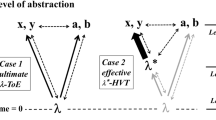Abstract
This paper draws attention to an increasingly common method of using computer simulations to establish evidential standards in physics. By simulating an actual detection procedure on a computer, physicists produce patterns of data (‘signatures’) that are expected to be observed if a sought-after phenomenon is present. Claims to detect the phenomenon are evaluated by comparing such simulated signatures with actual data. Here I provide a justification for this practice by showing how computer simulations establish the reliability of detection procedures. I argue that this use of computer simulation undermines two fundamental tenets of the Bogen–Woodward account of evidential reasoning. Contrary to Bogen and Woodward’s view, computer-simulated signatures rely on ‘downward’ inferences from phenomena to data. Furthermore, these simulations establish the reliability of experimental setups without physically interacting with the apparatus. I illustrate my claims with a study of the recent detection of the superfluid-to-Mott-insulator phase transition in ultracold atomic gases.
Similar content being viewed by others
References
Bogen J., Woodward J. (1988) Saving the phenomena. The Philosophical Review 97(3): 303–352
Bogen J., Woodward J. (2003) Evading the IRS. Poznan Studies in the Philosophy of the Sciences and the Humanities 20: 223–256
Chang H. (2004) Inventing temperature: Measurement and scientific progress. Oxford University Press, Oxford
Clark S. R., Jaksch D. (2006) Signatures of the superfluid to Mott-insulator transition in the excitation spectrum of ultracold atoms. New Journal of Physics 8(8): 160
Franklin A. (1997) Calibration. Perspectives on Science 5(1): 31–80
Galison P. (1997) Image and logic. University of Chicago Press, Chicago
Greiner M. et al (2002) Quantum phase transition from a superfluid to a Mott insulator in a gas of ultracold atoms. Nature 45: 39–44
Hartmann, S. (1996). The world as a process: Simulations in the natural and social sciences. In R. Hegselmann et al. (Eds.), Modelling and simulation in the social sciences from the philosophy of science point of view (pp. 77–100). Theory and decision library. Dordrecht: Kluwer.
Hubbard J. (1963) Electron correlations in narrow energy bands. Proceedings of the Royal Society of London A 276(1365): 238–257
Hughes R. I. G. (1999) The Ising model, computer simulation and universal physics. In: Morgan M. S., Morrison M. (eds) Models as mediators: Perspectives on natural and social science. Cambridge University Press, Cambridge, pp 97–145
Humphreys P. (2004) Extending ourselves. Oxford University Press, Oxford
Keller E. F. (2003) Models, simulation, and computer experiments. In: Radder H. (eds) The philosophy of scientific experimentation. University of Pittsburgh Press, Pittsburgh, pp 198–215
Merz, M. (2006). Locating the dry lab on the lab map. In Lenhard, J., Kuppers, G., & Shinn, T. (Eds.), Simulation: Pragmatic construction of reality (Vol. 25, pp. 155–172). Sociology of science yearbook. Dordrecht: Springer.
Morgan M. S. (2002) Model experiments and models in experiments. In: Magnani L., Nersessian N. J. (eds) Model based reasoning: Science, technology, values. Kluwer, New York, pp 41–58
Parker W. (2009) Does matter really matter: Computer simulations, experiments, and materiality. Synthese 169(3): 483–496
Stöferle T., Moritz H., Schori C., Köhl M., Esslinger T. (2004) Transition from a strongly interacting 1D superfluid to a Mott insulator. Physical Review Letters 92(13): 130403(4)
Vidal G. (2003) Efficient classical simulation of slightly entangled quantum computations. Physical Review Letters 91(4): 147902(4)
Winsberg E. (2003) Simulated experiments: Methodology for a virtual world. Philosophy of Science 70(1): 105–125
Winsberg E. (2009) A tale of two methods. Synthese 169(3): 575–592
Woodward J. (2000) Data, phenomena and reliability. Philosophy of Science 67: S163–S179
Author information
Authors and Affiliations
Corresponding author
Rights and permissions
About this article
Cite this article
Tal, E. From data to phenomena and back again: computer-simulated signatures. Synthese 182, 117–129 (2011). https://doi.org/10.1007/s11229-009-9612-y
Received:
Accepted:
Published:
Issue Date:
DOI: https://doi.org/10.1007/s11229-009-9612-y




